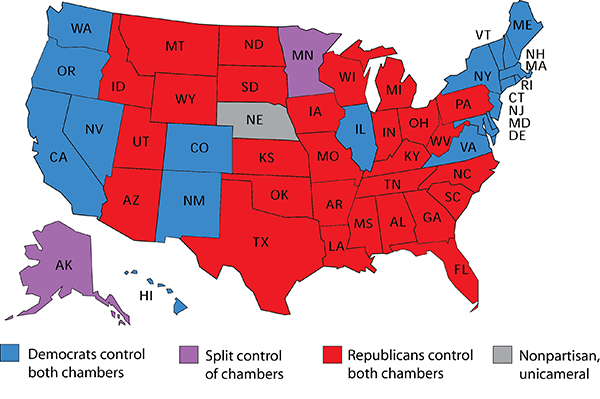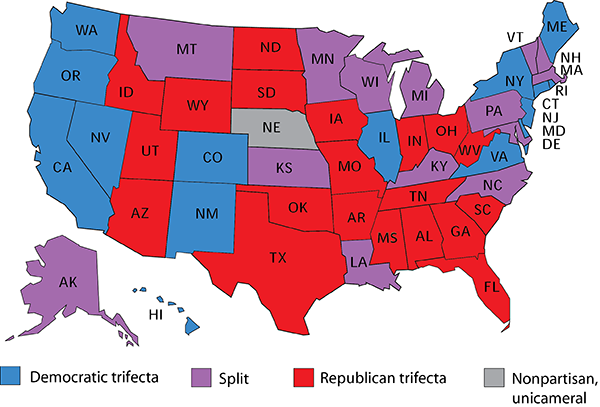| Dear Readers: We’re pleased this week to welcome Chaz Nuttycombe to give an overview of state legislative elections in 2020. While we at the Crystal Ball do not do specific race ratings for state legislative races and chambers, we wanted to provide you with an update on these races, and Chaz follows and rates these races at the election forecasting site CNalysis.com.
— The Editors |
KEY POINTS FROM THIS ARTICLE
— Republicans have more vulnerable state legislative chambers than Democrats.
— Nationwide, Democrats are currently projected to have a small net gain in state Senate seats, whereas Republicans are projected to have a small net gain in state House seats.
— Very few new state government trifectas are going to be created this year.
The battle for the state legislatures
There’s a lot at stake on the federal level this year: the presidency, the Senate, and the House are all up for grabs. While there has (rightfully) been considerable attention and speculation dedicated to these larger races, the upcoming state legislature elections have not received the same level of consideration.
With more than 5,000 districts at stake this year, there are many opportunities at the state level for either party to maintain or improve their advantage. We at CNalysis acknowledge the importance of these elections; we are currently casting ratings for most of these districts — 5,233 to be exact — as well as their respective state legislative chambers.
Before getting into the specific ratings, let’s take a look at where things stand right now. Map 1 shows the current party control of state legislative chambers. Notice that there are only two states where party control of chambers is divided: In Minnesota, Democrats control the state House and Republicans hold the state Senate, while in Alaska, Republicans hold the state Senate while Democrats nominally control the state House thanks to a coalition of Democrats, Republicans and Independents (Republicans actually hold more seats in the chamber). Also, Nebraska’s unicameral state legislature is technically nonpartisan, although functionally it’s GOP-controlled. Overall, control of state legislatures aligns with 2016 presidential partisanship: Democrats control all the chambers in states won by Hillary Clinton except for the Minnesota Senate, while Republicans control all the chambers in states won by Donald Trump except for the Alaska House.
Overall, Republicans control 58 chambers, and Democrats control 40. Again, this tally excludes Nebraska.
Map 1: Control of state legislative chambers

The term “trifecta” is used by analysts to denote states where both chambers of the state legislature and the governorship are controlled by the same party. Map 2 shows the states that have either Democratic or Republican trifectas versus those where there is some split in power. Republicans have 20 trifectas, Democrats have 15, and 14 states are split. Again, Nebraska is excluded, but functionally the state could be counted as one where Republicans control both the governorship and legislature.
Map 2: State trifectas

With that, here are our current CNalysis ratings of the state legislative chambers. States not listed either are safe for the incumbent party or do not have state legislative elections this year.
Table 1: CNalysis state legislative chamber ratings

As our ratings indicate, Republican-controlled chambers are more competitive than those held by Democrats. While Republicans hold an advantage in the number of chambers they control, the certainty of Republicans maintaining such a lopsided control of chambers is not assured. Of the competitive chambers that Republicans control, most are closer to the Toss-Up category than the competitive chambers Democrats control. Excluding the “Likely” chambers — where the chances of a chamber flipping are possible but slim — there are 11 competitive chambers remaining: nine held by Republicans, and just two held by Democrats.
This is largely due to the so-called “blue wave” of 2018, where Democrats had a net gain of 65 state Senate seats and 240 state House seats in the midterm elections. Given what might be a more even-handed electoral environment we’ll see in a presidential election year compared to a midterm election, which almost always delivers rebukes to incumbent presidents, we will likely see far smaller net gains for either party.
In 2016, Republicans had the overall net gain in state legislative seats, with many newly-elected Republicans being carried by Donald Trump’s coattails in rural areas, where he dominated. Republicans had a net gain of 31 state Senate seats and a single state House seat nationwide. Currently in the CNalysis forecast of over 5,000 single-member state legislative districts, Democrats are favored to have a net gain of 11 state Senate seats, and Republicans are favored to net 11 state House seats. Given how many seats are being contested, this would be a very modest shift in seats.
The projected Democratic net gain in state Senate seats is mostly due to two reasons: staggered terms and open seats. In the staggered term districts, where there hasn’t been an election since the 2016 elections, there are several districts that have drifted sharply leftward since then, mostly in suburban areas. The projected Republican net gain in state House seats is also mostly due to two reasons: open seats and seats that went uncontested in 2016 and/or 2018. The districts that are projected to flip to Republicans are almost entirely in rural areas.
Currently, in the CNalysis ratings for 5,233 single-member districts in both state Senates and state Houses around the country, only about 20% of all the districts are competitive, with the remainder either safe for one party or the other or uncontested. The uncontested districts, where only members of one party are running, will continue to increase as more candidacy filing deadlines pass in more states throughout the year. More than 90% of these uncontested districts would not have been competitive. So just like in the U.S. House of Representatives, a strong majority of state legislative seats do not really feature much two-party competition.
Of the 17 competitive state legislative chambers, nine are in states where there is not a state government trifecta: The Minnesota House and Senate, the New Hampshire House and Senate, the Alaska House, the North Carolina House and Senate, the Michigan House, and the Pennsylvania House.
Minnesota is the greatest opportunity for Democrats to create a trifecta in state governments this year, with only the state Senate standing in their way. North Carolina and New Hampshire double as trifecta opportunities for both parties, because both states have competitive state legislative chambers and gubernatorial races. Alaska Republicans only have to flip the state House to create a trifecta in the state, though that will depend on how they fare against Republicans in the chamber who caucus with the Democrat-aligned majority coalition (more on that here).
Eight of the competitive state legislative chambers are in states where there is either a Democratic or Republican trifecta: the Connecticut Senate, the Maine House and Senate, the Iowa House, the Arizona House and Senate, the Texas House, and the Florida House. If any of these chambers flip, with some more likely to than others in this list, it would create a divided state government. A few of these states have historically practiced gerrymandering, with Texas being the biggest offender. So depending on the state, a divided government could help combat gerrymandering during the redistricting processes next year.
Michigan and Pennsylvania, two crucial states in the Electoral College for both parties, will not become either a Republican or Democratic trifecta this year. Michigan’s state Senate isn’t up until 2022, and there’s no path to a Democratic majority in the Pennsylvania state Senate thanks to a Democrat who switched parties last year and caucuses with Republicans (though they could get a tied chamber with Democratic Lt. Gov. John Fetterman as the tiebreaker). However, both of their state Houses are competitive, with Michigan looking like the better target. If Democrats flip the state Houses, they’d be one step closer to a trifecta that they could create in 2022, although they will have to defend the governorships of each of those states that year as well.
So overall, the Republican goals in state legislatures are to:
— Create more Republican trifectas and create divided governments in Democratic trifectas.
— Keep and expand their current projected net gain in state House seats, defeating more rural blue dog Democrats who hold districts that President Trump won heavily.
— Stand their ground in suburban areas Democrats have been gaining in, and possibly flip back some Trump-won suburban seats they lost in 2018.
The Democratic goals in state legislatures are to:
— Create more Democratic trifectas and create divided governments in Republican trifectas.
— Keep and expand their current projected net gain in state Senate seats by mostly flipping Clinton-won suburban seats that haven’t had an election since 2016, and minimize damage in state House seats.
— Continue to gain in suburban areas they gained in in the 2018 midterms and defend their earnings mostly in those areas from that election.
| Chaz Nuttycombe is director of the election forecasting group CNalysis.com. Follow him on Twitter @ChazNuttycombe. |
